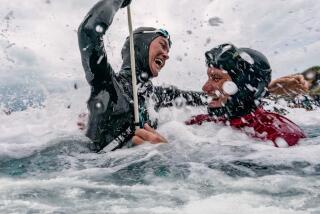200 Divers Get Straight Talk on the Bends
- Share via
Sometimes knowledge is a matter of life or death.
That is a maxim for scuba divers, who must be acutely aware of their equipment, water conditions and their own health. More than 200 diving enthusiasts crowded into a room at Columbia Los Robles Hospital on Thursday night to learn more about their sport’s greatest threat--the bends.
“Prevention is nine-tenths of the law in this case,” said Dr. J.B. Wilmeth, longtime director of the hospital’s hyperbaric unit. “It [the bends] is very dangerous, but it can be prevented and that’s what we’re here to do.”
Despite its seemingly benign moniker, the bends, also called decompression illness, is sometimes fatal. The illness strikes when divers return to the surface too fast to allow the dissolved nitrogen in their bloodstream to be filtered out through the lungs.
If a diver ascends too fast, the pressurized nitrogen expands into bubbles that can cause everything from severe pain to disorientation to paralysis and even death.
The condition, if caught early, can be treated in a hyperbaric chamber--a long tube that is pressurized to allow the nitrogen to be dissolved and then exhaled.
Columbia Los Robles has the county’s most extensive facility to treat the bends. Its three hyperbaric chambers treat about nine divers a year.
The number of scuba divers has swelled in recent years, with more than 4 million in the United States. But better equipment and safety awareness have kept the number of cases of the bends to a minimum, according to Wilmeth, director of the unit for the past 25 years.
“It’s an extremely safe sport if you consider the number of people who do it and the number who get into trouble,” he said. “However, it’s still very important that everyone who dives be safe.”
The rigors of underwater exploration and recreation begin in 320 BC when Alexander the Great took his first look at the aquatic world while being lowered into the water in a glass container. The event is considered the first dive.
At about the same time, Aristotle, who was Alexander’s tutor and philosopher, noted in a journal that the increased pressure underwater sometimes caused eardrums to rip. It was the first indication of the health threats of diving.
In 1670, doctors diagnosed their first case of decompression illness. In 1841, the first hyperbaric chamber was developed.
Before scuba divers are certified, they receive training in how to prevent decompression illness, but not in the detail offered by the hospital program, officials said. Thursday’s seminar was well-received.
“You really can never be too careful when you’re down there, but I know it’s easy to get distracted and forget about everything you’re supposed to do,” said Anthony Podhoretz, 29, of Moorpark.
This first seminar at Columbia highlighted the symptoms common to the illness, and featured members of the Coast Guard, who talked about how the agency responds to diving accidents and injuries. Their presentation included a tour of a rescue helicopter and tips on what to do during a Coast Guard response.
Veteran diver and instructor Alan Miller emphasized the need to follow a dive plan, check dive depth tables for making a safe ascent, and use caution at all times, particularly in Southern California waters.
“We’ve got a beautiful place to dive here in California,” he told the group. “But there’s virtually no place that’s flat so you’ve got to always be conscious of your depth.”
The seminar ended with a short lecture by Wilmeth on the symptoms, effects and latest treatments for decompression illness, including the hospital’s hyperbaric unit.
“It sure opened my eyes,” said Barbara Meissler of Agoura Hills. “I just hope I never have to use anything that I learned here tonight.”
More to Read
Sign up for Essential California
The most important California stories and recommendations in your inbox every morning.
You may occasionally receive promotional content from the Los Angeles Times.













